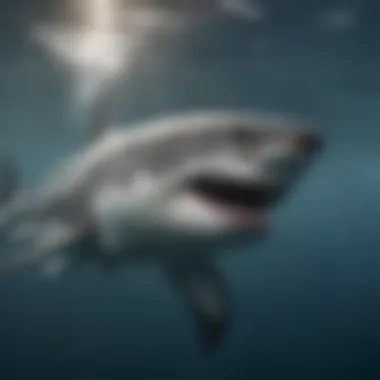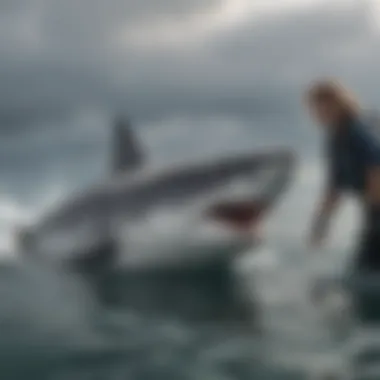Exploring the Conservation Status of Great White Sharks: A Detailed Analysis


Nature Topic Overview
Great white sharks, with their iconic appearance and immense size, have long been a subject of fascination and fear. In the vast ocean waters, these majestic predators roam, commanding both respect and curiosity. However, the question of whether great white sharks are endangered looms large, prompting a closer look into their current status and the challenges they face in their natural habitat.
Fun Facts and Trivia
As intimidating as they may seem, great white sharks are essential in maintaining the balance of marine ecosystems. These apex predators play a crucial role in regulating the population of marine species, ensuring a healthy biodiversity in the oceans. Additionally, their impressive speeds exceeding 25 miles per hour make them one of the fastest marine animals, capable of swift and agile movements as they navigate the deep waters.
Wildlife Explorations
Aside from great white sharks, the ocean is home to a myriad of fascinating species. From the graceful movements of manta rays to the elusive nature of whale sharks, exploring the diverse marine life offers insights into the interconnectedness of ocean ecosystems. Creatures like sea turtles and dolphins add to the tapestry of marine biodiversity, each contributing uniquely to the vitality of our oceans.
Environmental Awareness
The conservation of great white sharks is not just crucial for their survival, but for the health of the entire marine environment. By understanding the importance of protecting these apex predators, we take a significant step towards preserving the delicate balance of ocean ecosystems. Children can actively participate in conservation efforts by spreading awareness about the conservation status of great white sharks and promoting sustainable practices that safeguard these magnificent creatures.
DIY Nature Activities
Engaging in nature-inspired activities can further enhance children's appreciation for marine life. Creating shark-themed crafts or conducting experiments to understand the unique adaptations of great white sharks can spark curiosity and a deeper connection to the marine world. Outdoor explorations that focus on marine conservation efforts can instill a sense of responsibility and empathy towards protecting these majestic creatures.
Introduction


In the vast oceans of our planet, a majestic creature reigns supreme - the great white shark. This apex predator, with its iconic sleek profile and rows of razor-sharp teeth, captivates the imagination of both young and old. However, beyond its fearsome reputation lies a creature shrouded in mystery and vulnerability. The importance of understanding the status of great white sharks cannot be overstated, as it sheds light on the delicate balance of marine ecosystems and the impact of human activities on these magnificent beings.
To comprehend the current situation of great white sharks and determine if they are endangered, a holistic approach is necessary. By examining the physical characteristics that define these creatures and delving into their intricate habitats and behaviors, we gain a profound insight into their world. This exploration not only uncovers the unique adaptations that have allowed great whites to thrive for millions of years but also underscores the challenges they face in the modern era.
From the sun-dappled waters of the Pacific to the swirling depths of the Atlantic, great white sharks navigate a complex tapestry of environments. Their migratory patterns and hunting behaviors are finely tuned to the rhythms of the ocean, making them indispensable to marine ecosystems. However, as human activities encroach upon these fragile habitats, the very survival of these apex predators hangs in the balance.
In the following sections, we will unravel the intricate web of threats that great white sharks encounter in their daily lives. From the perils of overfishing and bycatch to the nuanced dynamics of human interactions, each challenge poses a significant risk to the survival of these enigmatic creatures. Furthermore, the specter of pollution and climate change looms large, casting a shadow over the future of great white sharks and the ecosystems they inhabit.
As we embark on this journey of discovery, it becomes clear that conservation efforts play a pivotal role in safeguarding the future of great white sharks. Through international protection initiatives, robust research and monitoring programs, and active community involvement, concerted efforts are underway to protect these apex predators and ensure their continued existence. By unraveling the threads of population trends and exploring global estimates and regional variations, we can paint a comprehensive picture of the status of great white sharks and chart a course towards a more sustainable future.
Understanding Great White Sharks
Understanding Great White Sharks is crucial in exploring their current status and determining if they are endangered. By examining their physical characteristics, habitat, and behavior, a deeper insight into these creatures is gained. This section aims to shed light on the significance of comprehending Great White Sharks for conservation efforts and ecosystem balance. It delves into specific elements like their size, anatomy, and predatory behaviors that make them apex predators in marine ecosystems.
Physical Characteristics
Great White Sharks possess distinct physical characteristics that set them apart in the marine world. With their streamlined bodies, powerful jaws filled with rows of serrated teeth, and keen sense of smell, they are formidable hunters. Their large size, typically ranging from 15 to 20 feet in length, and impressive speed make them top predators. These attributes aid in their survival and dominance in their oceanic habitats, where they play a vital role in maintaining ecological balance.
Habitat and Behavior
The habitat and behavior of Great White Sharks are intricately linked to their survival and conservation. These apex predators are commonly found in coastal waters of temperate regions worldwide, known for their frequent presence near seal colonies. Their migratory patterns and feeding habits demonstrate their adaptability and importance in marine ecosystems. Understanding their behavior, such as breaching while hunting and social interactions, provides valuable insights for conservation efforts and effective protection strategies.
Threats to Great White Sharks


The section on threats to Great White Sharks is crucial in shedding light on the challenges faced by these majestic creatures. Understanding the various dangers they encounter is vital in assessing their overall vulnerability. By exploring the factors that put great white sharks at risk, we gain insight into the complex relationship between these predators and their environment. This section delves into the intricate balance that must be maintained to ensure the survival of this apex predator.
Overfishing and Bycatch
Overfishing and bycatch pose significant threats to great white sharks. The rapid depletion of marine resources due to overfishing disrupts the food chain, affecting the availability of prey for these sharks. Bycatch, the unintentional capture of sharks in fishing gear targeting other species, further diminishes their numbers. The detrimental impact of overfishing and bycatch on great white shark populations highlights the urgent need for sustainable fishing practices and conservation efforts to protect these apex predators.
Human Interactions
Human interactions present a complex challenge for great white sharks. Misunderstandings and conflicts arise as these sharks occasionally come into contact with humans in shared coastal waters. While shark attacks garner attention, it is essential to recognize that these incidents are rare and often result from mistaken identity. Understanding the role of human behavior in shaping these interactions is key to promoting coexistence between great white sharks and coastal communities.
Pollution and Climate Change
Pollution and climate change have emerged as significant threats to the marine ecosystem, impacting great white sharks. From plastic debris clogging their habitats to rising sea temperatures altering migration patterns, these environmental stressors jeopardize the well-being of these apex predators. As guardians of the oceans, addressing pollution and climate change is imperative to safeguarding the future of great white sharks and preserving marine biodiversity.
Conservation Efforts
In the realm of preserving wildlife, the imperative of conservation efforts for great white sharks cannot be overstated. With these majestic creatures facing numerous threats, concerted actions are indispensable to safeguard their existence. Conservation efforts encompass a multifaceted approach that involves various stakeholders, from governments to nonprofits, dedicating resources and expertise to protect these apex predators. By focusing on conservation, we aim to mitigate the detrimental impacts of human activities that endanger the survival of great white sharks. Through a combination of research, policy-making, and public awareness campaigns, conservation efforts strive to ensure the long-term viability of these iconic marine species.
International Protection
One of the key pillars of conserving great white sharks is the establishment of international protection measures. Given the migratory nature of these sharks across different oceanic regions, collaborative efforts on a global scale are crucial. International agreements and conventions play a pivotal role in regulating fishing activities, establishing marine protected areas, and enforcing regulations to combat illegal trade. By fostering international cooperation, countries can harmonize conservation strategies and amplify their impact on safeguarding great white shark populations worldwide.
Research and Monitoring Programs


Complementary to international protection initiatives are research and monitoring programs designed to provide scientific insights into the behavior and ecology of great white sharks. These programs involve tagging and tracking efforts, population assessments, and ecological surveys to gather essential data for informed conservation decision-making. By studying the movement patterns, reproductive biology, and feeding habits of great white sharks, researchers can delineate conservation priorities and tailor interventions to address specific threats faced by these apex predators. Through continuous monitoring, gaps in knowledge can be filled, leading to more effective conservation strategies.
Community Involvement
Engaging local communities in conservation efforts is paramount to fostering sustainable coexistence between humans and great white sharks. Community involvement initiatives aim to raise awareness about the importance of these apex predators in marine ecosystems and promote responsible ecotourism practices. By involving coastal communities, fisherfolk, and marine conservation organizations, a sense of stewardship towards protecting great white sharks can be cultivated. Additionally, educational programs and outreach activities empower communities to become advocates for marine conservation, contributing to a collective effort in safeguarding the fragile balance of the oceanic food web.
Population Trends
In the context of this article, understanding the population trends of great white sharks is paramount to evaluating their conservation status. Population trends provide crucial insights into the health and sustainability of these apex predators, influencing conservation strategies and management policies. By examining the fluctuation in great white shark numbers over time, researchers can identify patterns, determine potential threats, and pinpoint areas for intervention. This section will delve into the significance of monitoring population trends and its implications for the long-term survival of great white sharks.
Global Population Estimates
Global population estimates of great white sharks serve as a fundamental component in assessing the overall conservation status of this species worldwide. These estimates offer valuable data on the projected numbers of great white sharks across different regions, shedding light on population dynamics and distribution patterns. Understanding the global population estimates enables researchers and conservationists to gain a comprehensive overview of the species' abundance, aiding in the identification of critical habitats and migration routes. Moreover, global population estimates play a pivotal role in informing international conservation efforts and collaborations aimed at safeguarding great white sharks on a global scale.
Regional Variations
Examining regional variations in great white shark populations is essential for comprehending the species' ecological resilience and vulnerability in specific geographical areas. Regional variations take into account factors such as environmental conditions, prey availability, human activities, and conservation measures implemented at the local level. By analyzing regional population data, researchers can uncover disparities in population densities, genetic diversity, and reproductive success rates among different great white shark populations. Understanding these variations is vital for tailoring conservation strategies to address region-specific challenges and ensure the sustainable management of great white sharks across diverse marine ecosystems.
Conclusion
In the realm of assessing the status of great white sharks and the critical question of whether they are endangered, the significance of arriving at a conclusion cannot be overstated. Through a meticulous examination of various facets such as population trends, threats faced, conservation efforts, and global perspectives, this article journeys deep into unraveling the mystique surrounding these majestic creatures. In essence, the conclusion draws together these intricate threads to paint a holistic portrait of the current scenario concerning great white sharks.
Delving into the nuanced details of population trends unveils a tapestry of data, shedding light on the shifting dynamics of great whites globally while also highlighting regional variations that underscore the diverse challenges faced by different populations. By meticulously dissecting these trends, we gain invaluable insights into the health and well-being of these apex predators, allowing for informed decisions and targeted conservation measures.
Moreover, exploring the threats looming over great white sharks reveals a somber narrative fraught with perils such as overfishing, bycatch, human interactions, pollution, and climate change. Each of these factors poses a unique threat to the survival of these creatures, necessitating urgent action and strategic planning to mitigate these risks and secure a safer future for great whites.
On the flip side, the discussion on conservation efforts offers a glimmer of hope amidst the bleak landscape of challenges. From international protection initiatives to grassroots community involvement and cutting-edge research programs, a mosaic of conservation endeavors is underway to safeguard the future of great white sharks. The conclusion encapsulates the essence of these efforts, reiterating the significance of collective action and sustained commitment in safeguarding these iconic oceanic residents.
Ultimately, the conclusion serves as a poignant reminder of the delicate balance at play in the realm of great white sharks and the imperative of informed decision-making to ensure their continued existence. By synthesizing the wealth of information presented throughout this article, readers are implored to reflect on their roles in the broader conservation narrative and the profound impact of individual actions on the fate of these magnificent creatures. The conclusion thus acts as a call to action, urging stakeholders at all levels to band together in a united front to protect and preserve the awe-inspiring legacy of great white sharks.







